Museum affairs. Schiavona from the regional museum
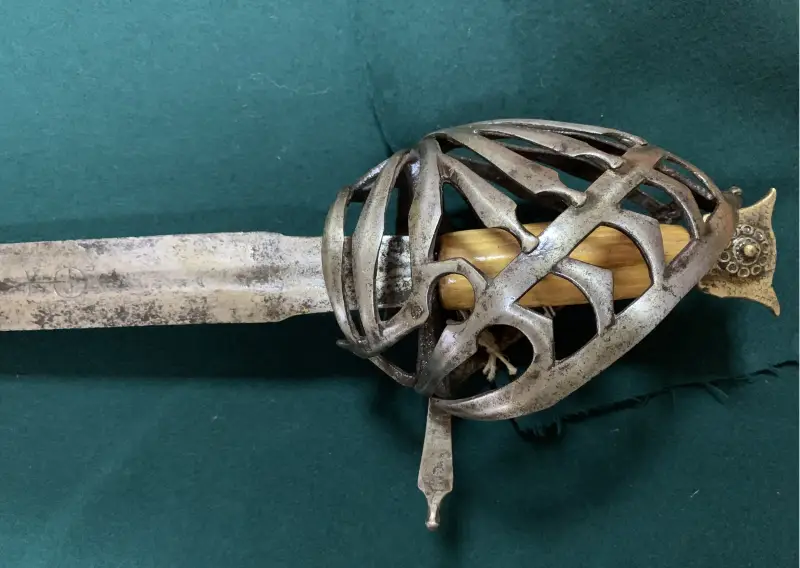
Schiavon from the funds of the Penza Regional Museum of Local Lore. Author's photo
We left the yard.
“I’ll take you to the museum!” –
Sister told me.
Here we are walking through the square.
And we finally enter.
In a big, beautiful red house,
It looks like a palace.
Sergey Mikhalkov. In the V. I. Lenin Museum
Culture and story. We are starting another cycle, in which we will talk about weapons, which the author had the opportunity to meet personally, hold in his hands and even... “dig deeper” into it a little. This is always more interesting to write about than something with which you are familiar solely from other people’s texts. However, how could it be otherwise? The author who wrote the article about the American ATASAM missiles, without a doubt, was not even close to it. Authors of articles about tanks “Abrams” and “Challenger” were also unlikely to ride them, but... they made their own materials, rewriting others, with an emphasis on the percentage of novelty.
I already wrote once that due to the specifics of the modern information space, 90% are nothing more than rewriting. And to be indignant at this state of affairs is simply stupid. How to write interesting material, say, about wheeled pistols of the XNUMXth–XNUMXth centuries? You can, of course, go to St. Petersburg and ask to go to the storerooms to look at them there, hold them in your hands, measure them... Anything is possible! You can also go to the Dresden Armory, and even now, by plane via Istanbul. But... it will cost such a pretty penny that only the crazy owner of a neodymium mine, who simply has nowhere to put the money, will be able to do it. But why should he write about them then? So the problem of finding new interesting materials for publication in mass media continues to be very acute today.
That’s why, in conditions when some museums in the country ask you for 12 rubles for one single photograph, and such an amount as 700-4 thousand for one photo (or for the right to publish it) is considered “normal,” you have to rejoice at any opportunity “ hold on to antique weapons for free and take photographs from them, for which you will not be taken to court later.
And recently I had such an opportunity. The Penza Regional Museum of Local Lore has decided to release a colorful catalog of its exhibits, which, of course, will also include weapons. I was invited to “look” at it and correct all the absurdities that were in the descriptions of certain exhibits. And they were described completely incorrectly. The weight of the weapon was not indicated; for firearms, the barrel length and overall length were not indicated. Naturally, nothing was written there about the caliber either, and no one knew how the caliber of the fittings was measured either. And this is by no means a reproach to the museum workers. Museum studies are not taught at our pedagogical institute. Perhaps somewhere in Moscow. But who today, having received a diploma in museum studies, will travel from Moscow to Penza?
So many young professionals who get to work there have to figure everything out on their own or study in courses that are rarely organized. Well, a huge role is played by low wages, which are so small that it’s embarrassing to even name them. That is, real enthusiasts of their work or women work there... who need work that is not too hard and intense. Although how can I say this? When my wife worked there in the mass department (1980-1984), she had to lead excursions literally one after another. And now, by the way, everything is the same, only now people come not only in groups, but also book personal excursions for one family of 2-3 people. I saw it myself...
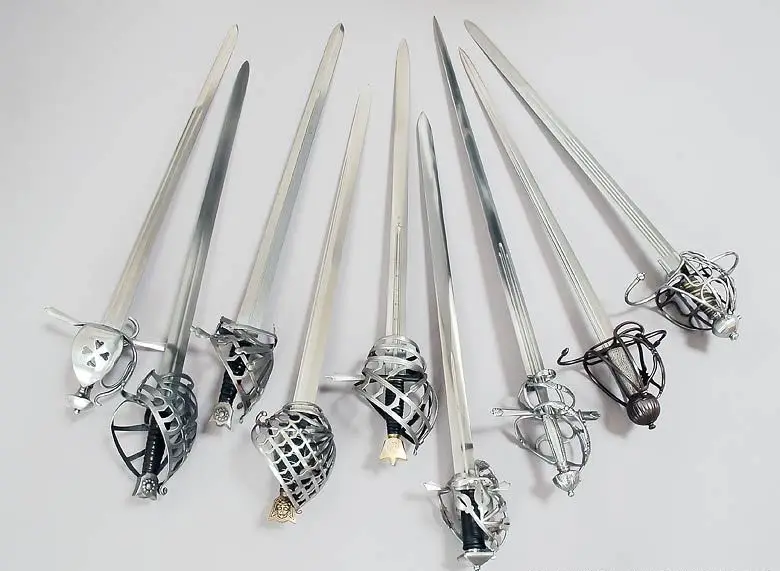
Schiavones for every taste. Photo by Nathan Robinson, myArmoury.com
In general, life is a strange thing. I remember well that I came to our local history museum back in the summer of 1960. It made a simply amazing impression on me then: a huge mammoth skeleton reaching to the ceiling; illuminated dioramas with the animal and plant world of ancient eras, a diorama with a cave of primitive people and the same people stoning a cave bear. Naturally, the weapon also caught my attention. I remember a Turkish gun inlaid with brass patterns, then an Oriental gun, most likely of Balkan workmanship and a bone buttplate, Turkish scimitars and... a commissar Mauser (which was stolen from the museum at the same Soviet time by breaking a window and sawing through the bars!).
Then, already in the early 80s, the then director of the museum ordered me models of ships on which Penza residents served and fought: the battleship Potemkin, the cruiser Aurora, the cruiser Varyag and Bogatyr. Models from the Ogonyok plant came to the rescue, but, of course, they were heavily converted. Then he bought the “Freedom Fighter Comrade” tank from me. Lenin” (I still don’t know which side of the tank he needed it from) and T-34/76, because it was on this tank of Alexander Ivanovich Milyukov (our fellow countryman from Narovchat) that there was such an inscription. And who became famous for the fact that in the battles on the Kursk Bulge he took part in a tank duel with the German “Panther” and... emerged victorious! I remember that with this money, our whole family again went on vacation somewhere at sea and had a very good time there.
I visited the museum very often at that time, but all the weapons from the stands were then removed after the theft of the Mauser, and it became not as interesting there as before. Well, then I went to work at our polytechnic institute and took my wife with me to an easier job - as a document specialist at the neighboring philosophy department.
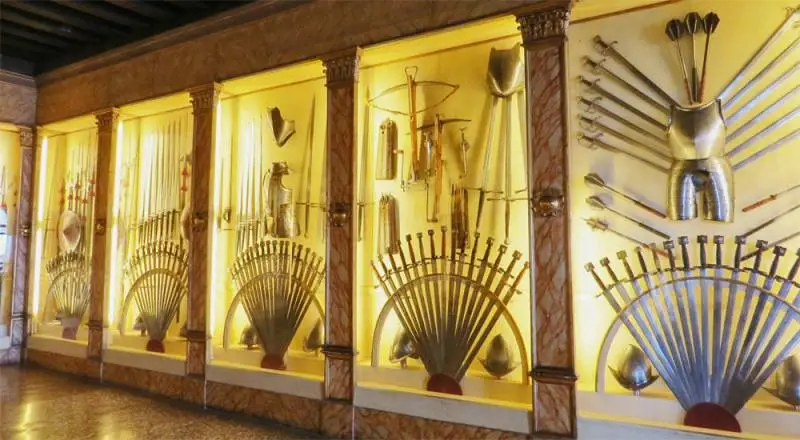
The predecessors of our schiavone in the arsenal of the Doge's Palace in Venice. Author's photo
And there is another rather strange problem. Or rather, a legal incident. Let’s say you came to a museum, paid money for photography and took photographs of the exhibits you needed without a high-definition camera or special lighting. The question is – who do these photos belong to? For you or the museum? “Of course, me!” – any VO reader will probably answer. And he will be only partly right. Because he can only use them for personal interests, say, post them in the comments. But if this person wants to insert them as illustrations into a book, then he will need... permission from the museum to publish them. Everything is like Matroskin’s cat: “The cow is the state cow, but the milk is ours!” And you cannot touch the “cow” without the appropriate paper. And in it, in this paper, there should be all your photos and it should be written that the museum does not object to their use and, moreover, allows them to be published free of charge.
Because it could be like this: you find on the Internet a photo of a famous painting from a famous museum. It was written in the 50th century. That is, in theory, it should have been in public use for a long time. But... where is it hanging? In the museum! So please pay us for her photo! Fortunately, there are museums in the world on whose website photographs are marked as “public domain,” that is, in public use. Moreover, it doesn’t matter to them whether you use them in a commentary on the VO website or in a book by AST/Eksmo publishing house. Otherwise, you won't be able to avoid trouble. For example, the Military History Museum in Vienna. A photograph of the exhibit from his website costs... XNUMX euros. However, if you can prove that your book is written for children and is educational in nature, you may be given permission to use it for free. But this is there, in the decaying West. With us, even if a photograph goes into a collection of fairy tales for children, you will have to pay for it, although only the lazy person would not have posted the same photo on the Internet.
That is why we have to be most sincerely glad that somewhere on the periphery art, and artifacts of the past are always art, still belongs to the whole people, and there is an opportunity to introduce these very people to it with minimal markups on the cost of publication. For example, we have, again in St. Petersburg, an excellent publishing house, Atlant. Prints wonderful books on weapons. But the price is 4900 rubles. without delivery, it is prohibitively large for the general reader. And who will ultimately buy such books? Perhaps single professionals, but not school-age children and not their parents.
And, of course, it’s always nice not only to be able to freely take photographs of a weapon, knowing that it’s free, but also to simply hold onto it, feel its heaviness, evaluate the ease of handling on your hand, wave the blade...
And today we will tell you about one such blade. Well, let's start with a little history, reminding our readers that the handle of a medieval sword was very simple, since they fought with such swords in plate gloves. But during the Renaissance, the sword began to gradually turn into a sword, which began to be held with a gloved hand, so gunsmiths began to develop more complex forms of hand protection. Starting with the ricasso, the handle began to be supplemented with various counterguards and either a cross with a long “whisker”, or a separate bar extending from the handle and bending towards the pommel. It was this evolution that led to the creation of a highly complex basket-shaped guard that provided the same protection to the wearer's hand as an armored glove.
And from the middle of the 16th to the 17th centuries. the shapes of the handles became even more complex. Thus, Ewart Oakeshott, a famous expert on European weapons and armor, noted that there is
He defined these types as follows: a simple handle, consisting of two plates and a pommel, to which the “Walloon sword (“Walloon sword” - V.O.) belongs; type of sword with a “Sinclair hilt”; misnamed "Grave Sword"; the British form, including the Scottish claymore and its relatives; and finally Schiavona.
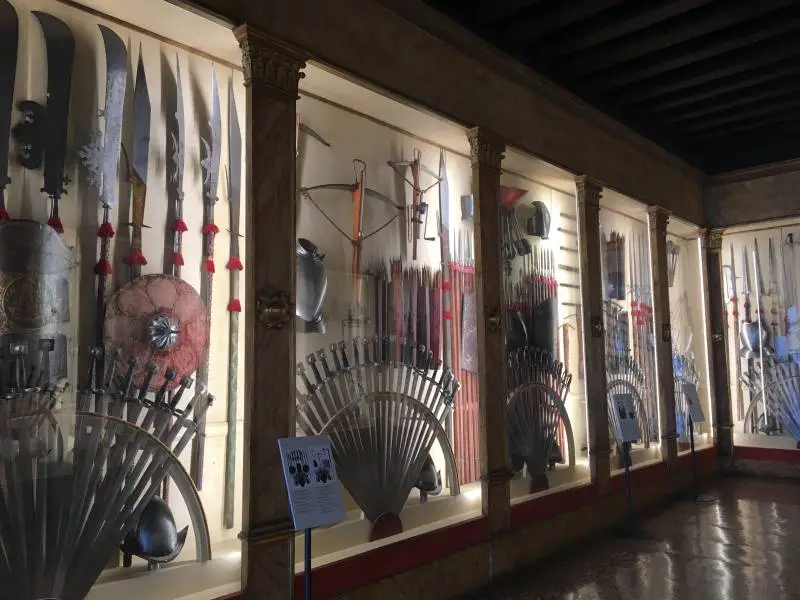
And in these showcases there are even more blades of predecessors, but they will be discussed in more detail in the next article. Arsenal of the Doge's Palace, Venice. Author's photo
So they brought it to me, and I involuntarily felt strong excitement, because the antiquity of this type of edged weapon was undeniable. I looked at the materials available on this type of edged weapon and for the museum card, which should be comprehensive but as brief as possible, I wrote the following:
***
Brief description of the exhibit: Schiavona. “Basket sword”, late 16th – early 17th century.
Place of creation: The blade was made in Passau, Germany. Material: Steel, wood.
Manufacturing technique: Forging.
Dimensions: Blade length 89,2 cm. Handle with pommel 14,5 cm. Ricasso width – 31,5 mm. After ricasso - 38 mm. At the tip – 28 mm. The blade thickness of the ricasso is 5,5 mm. At the tip – 2,0 mm.
Description: Schiavona. The handle lining has been replaced. Double-edged blade. The basket hilt belongs to the 2nd type of schiavon hilts.
Attribution: Initially, such weapons belonged to the Venetian Doge's Guard. Later it was a weapon of the cuirassier cavalry of the German states.
Brand: Judging by the brand - “running wolf” - production was carried out in Passau and it was typical for the 14th-15th centuries. In Solingen, blades were also marked with the image of a wolf, but the name “Solingen” was also written. There is no such inscription on this blade. There was even a lawsuit between Passau gunsmiths (southern Germany) and Solingen craftsmen (northern Germany), who also made swords with the mark of a wolf, but depicted them with an engraving with the inscription “Solingen” and the personal mark of the master.
Weapon design: Broadsword with a basket hilt. The finial is typically Venetian. But the socket on it could have been made anywhere.
History of use: Schiavona (Italian - Slavic) - a type of edged weapon, is one of the three most common forms of swords with a basket guard, along with the Scottish basket sword and howdegen.
And here is what is written about schiavona on the Internet: initially, in the 15th century, the word schiavona meant the swords that were armed with the guard of the Venetian doges; they had long straight blades, their distinctive feature was horizontally curved parry bows in the shape of the letter “S”. One can only add to this that their handles had a square pommel with slightly bent sides.
Since 1570, under Italian influence, a type of sword with an elongated blade and an original openwork basket hilt was formed in the German imperial army. The Spada Schiavona is obviously the direct descendant of these blades. Well, later all basket swords made in the Venetian style began to be called schiavona. The schiavona was characterized by a straight, double-edged blade about four centimeters wide and about 90 centimeters long. The long-bladed Schiavona was used by the cavalry and, under the Holy Roman Emperor Ferdinand II (1578–1637), by his cuirassiers.
State of preservation: good.
***
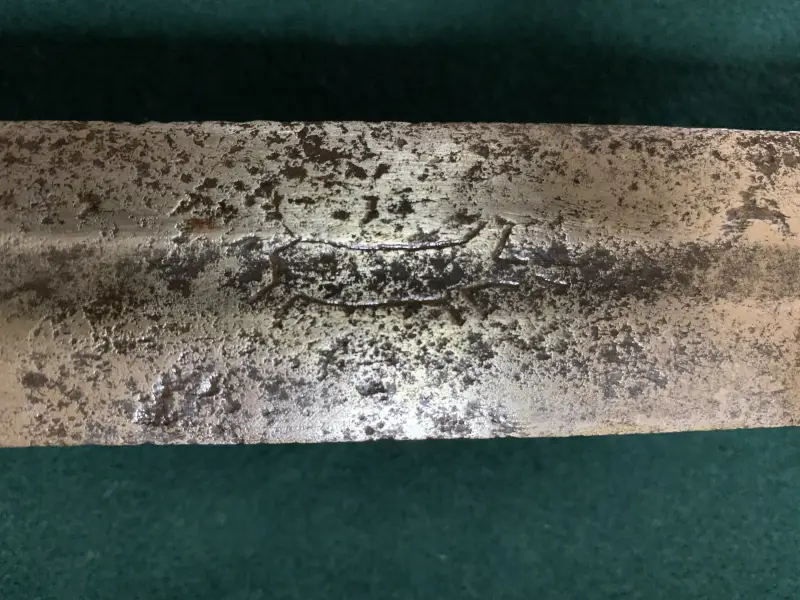
Schiavona blade with the image of a wolf. Penza Regional Museum of Local Lore. Author's photo
It seems that everything that is needed is stated. However, the topic seemed so interesting to me that we will continue the story about this interesting type of edged weapon in the next material.
To be continued ...
Information